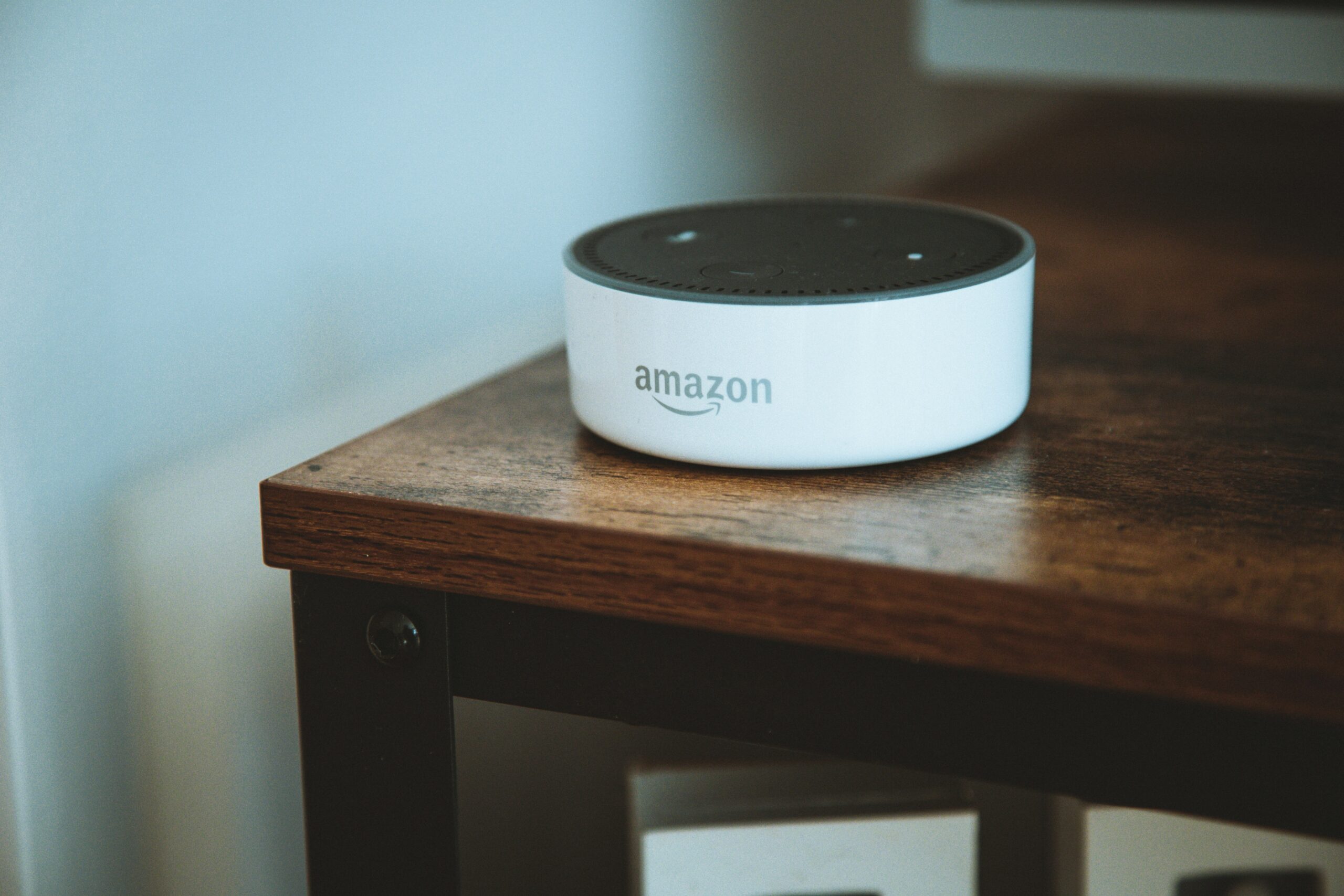Voice search in DACH: Top stats and trends for DACH businesses
Written by
Kinga EdwardsPublished on
Stay informed on voice search dynamics in DACH. Dive into essential statistics and simple trends that can boost your visibility.

DACH customers don’t search the way they used to. They don’t always type – they also ask. That’s because voice search in DACH is becoming an integral part of their everyday life.
From asking for store hours to finding nearby services, voice assistants are shaping how customers make decisions in real time. More searches happen on the go, often through smartphones, smart speakers, or in-car systems. All hands-free. It’s already changing what shows up in search results, how content gets read aloud, and which businesses get discovered first.
Today, you’ll find the latest stats, key voice trends for 2025, and simple steps to help your brand stay visible.
What is voice search (and how people use it today)
Voice search means speaking instead of typing. You ask your phone, smart speaker, or even your car a question, and it gives you an answer. That’s it. No screens, no swiping, just voice.
People use it to check the weather, play music, or search online. Some say things like:
- “Hey Siri, when does Lidl open?”
- “Alexa, what’s the best pizza place near me?”
- “OK Google, how do I fix a leaky faucet?”
And it’s growing fast. Predictions say that by 2027, 64% of Gen Z will be using voice assistants every month. The number can be even higher among those using smart speakers at home.
What’s driving this?
- Faster mobile networks
- Better voice recognition (even with regional accents)
- Busy people who prefer talking to typing
Voice queries are usually short, direct, and spoken in full sentences. Instead of searching “best hiking boots DACH,” someone might ask, “Which hiking boots are good for the Alps?” And the tone here is natural, like a conversation.
It’s also hands-free. That’s a big deal when someone is driving, cooking, or multitasking. In fact, PwC found that from 90% of respondents who know what a voice assistant is, as many as 72% have used them, on different devices:
As we can see, voice search happens across many devices:
- Smartphones – still the most common
- Tablets, laptops, desktops – really popular and often used
- Smart speakers – like Amazon Echo or Google Nest
- Smart TVs – for browsing content, like searching for a movie with a long title
- In-car systems – used during commutes
- Wearables – always with you, so easy to speak to them
And we’re not only talking about English. Voice assistants now handle German, Swiss German, and Austrian dialects much better than a few years ago. That’s important for DACH markets, where an accurate understanding of language and context really matters.
Which brings us to…
Voice search in DACH: what’s different?
Let’s zoom in on how voice search shows up in Germany, Austria, and Switzerland.
Language, dialects, and local habits
In the DACH region, people speak differently from city to city. Fortunately, device makers know it. Google Assistant and Alexa handle German, Austrian German, and Swiss German. Still, many users switch to High German when using voice search to improve accuracy.
Some users also adjust their phrases to match how they think a system will “understand.” That means businesses need to think about how people speak, not just how they type.
Examples of real searches:
- “Wann schließt die Post in Wien?” – “When does the post office in Vienna close?”
- “Wo kann ich Wanderschuhe in Luzern kaufen?” – “Where can I buy hiking boots in Lucerne?”
- “Bäckerei in meiner Nähe, die jetzt offen ist” – “Bakery near me that’s open now”
So this means: people speak in full questions, using their everyday language. All are location-based and often done on the go.
Adoption trends
Germany is leading the way in voice search for the DACH region. 39% of Germans use voice assistants regularly. In Austria, a 2021 survey found that 18% of Austrians use a voice or smart home assistant at home (roughly 910,000 users), and usage is growing among younger folks (34% of ages 16–24).
Switzerland is growing too, but at a slower pace, partly due to higher privacy concerns and multilingual complexities. French and Italian regions have slightly lower usage, but the German-speaking majority is catching up fast.
Smart speakers are rising, but mobile still dominates
Yes, the Amazon Echo is popular in German-speaking homes (to be honest, the Amazon brand is generally well-received in Germany). But most voice searches still happen on smartphones. Think: looking up local businesses, store hours, or product availability while out and about.
So if your company has a Google Business Profile, clear opening hours, location info, and a simple FAQ page – that’s already a good start for voice readiness.
Local SEO matters more than ever
Voice searches often begin with “near me,” “open now,” or “best in [city].” That’s where local SEO becomes a key strategy.
To show up in voice results, your site should:
- Use natural, question-style phrasing
- Answer common questions clearly and briefly
- Include your location, service area, and updated contact details
- Use structured data (FAQ markup helps!)
For example, a small bakery in Munich could optimize for:
- “Wo finde ich glutenfreies Brot in München?” “Where can I find gluten-free bread in Munich?”
- “Hat die Bäckerei Sonntag geöffnet?” – “Is the bakery open on Sunday?”
Answering these questions directly on your site—in plain German—helps you show up in voice results.
Top voice search stats & what they mean for DACH businesses
Let’s talk numbers—and why they matter to you in Germany, Austria, and Switzerland.
- There were 4.2 billion voice assistants globally, projected to reach 8.4 billion by the end of 2024.
- The smart speaker industry is expected to hit $110 billion by 2033.
- 34 % of non‑owners say they want to buy a voice assistant—late adopters are waiting in line
- Over 1 billion voice searches occur each month worldwide in 2024.
- A staggering 52% of smart speaker owners rely on voice every day.
- 39% of online shoppers recommend using voice searches to their friends and family.
- 56 % of smartphone users rely on voice search to learn about brands or businesses.
- 76% of consumers use voice to find local business info.
- 93% of users are satisfied with their voice assistant and appreciate the convenience, multitasking, and instant answers.
- 45.1% of users prefer Apple’s Siri over other voice assistants, especially for mobile use
- 65 % of 25–49 year‑olds use their voice‑enabled devices daily.
- Voice assistants answer 93.7 % of queries accurately, with an average voice result loading in 4.6 seconds.
- Featured snippets account for 41% of voice search results (fast, structured answers win).
- 75 % of global households were expected to own smart speakers by 2025.
- 71 % of wearable‑device users will use voice more in the future.
- Nearly 20 % of voice queries use the top 25 keywords like “how,” “what,” “best,” or “easy”.
- Voice search answers average 29 words, meaning short and clear responses work best.
- Google Assistant supports over 30,000 smart home devices.
- 71% of users use voice commands to play music.
So, what do all these stats tell us?
Simple: voice search is already here.
Whether it’s someone in Berlin asking their phone where to buy vegan shampoo, or a family in Vienna ordering pizza via Alexa, voice is shaping how people search, choose, and act.
For DACH businesses, this means it’s time to think beyond the screen. If 93% of users are happy with their voice assistants and over 75% of households are expected to have one, then your next customer might not be scrolling – they might be speaking. And if your business isn’t showing up in those spoken answers, you’re missing a growing slice of attention.
Optimizing for voice is about more than keywords. It’s about real questions, clear answers, and getting there quickly.
A quick tip: With 41% of voice results coming from featured snippets and answers averaging 29 words, your content needs to be short, structured, and spoken like a local.
Voice search trends shaping the DACH market
Voice search in DACH is a daily habit for many people. It’s a part of how they shop, find info, and interact with brands across Germany, Austria, and Switzerland.
So what’s really changing? And what should DACH businesses focus on next?
Here are the trends that matter most right now:
Voice search as a part of the daily routine
You don’t need to be tech-savvy to use voice search in DACH. The trick is to incorporate this technology into your daily activities. And that’s exactly what people are doing. They speak to their phones, cars, and smart speakers like it’s second nature.
In Germany, Austria, and Switzerland, this means that more customers are seeking time-savers and convenience.
Just look: you start with short, natural questions like “Where’s the closest bike repair shop?” or “What time does the café open on Sunday?” If your content doesn’t speak their language (literally) it won’t be part of the answer.
It’s not always a long session. It’s a quick, spoken check-in. And the trend is especially visible in mobile-first behavior.
New focus: shopping
As voice assistants become more reliable, people are getting comfortable using them to browse, compare, and even buy. In DACH markets, where convenience and clarity are paramount, voice-activated shopping is experiencing significant growth, especially for quick reorders, delivery, and product searches.
Yet, voice search is not about replacing e-commerce. It’s about making it easier to access.
With voice commerce expected to surpass $40 billion globally, this sector is prompting businesses to reassess their product descriptions and checkout flows. If someone says “Order more oat milk” or “Add hiking socks to cart,” your site needs to keep up.
Local reach matters
Local businesses are getting found through spoken searches. For them, voice is often the first step. That means your brand needs accurate info, updated hours, and local keywords ready to go.
It also means you need to think about your online presence like a storefront. If your phone number or map pin is off (yes, even slightly) you’re out.
Local SEO, structured data, and “near me” phrases in German can make a big difference. Especially in smaller towns, voice can be the only touchpoint between you and a new customer.
Younger users are leading the shift
Millennials and Gen Z don’t want to wait. They talk to their devices to get what they need, fast. Thus, for DACH brands, this means adapting your voice search presence to match their style, with:
- Short answers.
- Friendly tone.
- Mobile-ready.
They expect fast, conversational experiences that feel easy, not corporate.
It is quite logical that Gen Z has such requirements. After all, they grew up with Spotify voice commands and smart TVs. So they’re not going to “just type and browse”. They are they’re going to speak as well!
If your site still reads like a PDF or loads too slow, they’ll bounce.
Structure matters more than ever
Voice assistants pull answers from content that’s well-structured. The layout of your website—how questions are phrased, how fast the page loads, how clear the answer is—can decide whether you get read aloud or skipped. In voice search, clarity always wins.
You now know that featured snippets power 41% of voice responses. So think in questions: “Do you deliver to Innsbruck?” “What’s the best way to book?” Pages with quick, voice-friendly answers show up higher.
Even better if they load in under 5 seconds, because if the voice assistant times out, your chance is gone.
How can businesses approach voice search in DACH to get started?
This may sound like a lot of information at once, but look: you don’t need a massive tech team or a new website to show up in voice search. Most of the work starts with things you already control—your content, your local listings, and how you answer the questions your customers are already asking.
#1 Start with local SEO
Voice assistants pull a lot of answers from Google Business Profiles, Apple Maps listings, and local directories. So make sure yours is fully filled out and up to date, with:
- business hours
- phone number
- services
- and location info
Add photos and a short description that sounds like something you’d actually say out loud.
#2 Look at how your content sounds
Voice searches are full of natural, everyday questions. Your website should reflect that. Use simple headers written as real questions, and keep answers short. Under 30 words works best.
#3 Add an FAQ section if you don’t already have one
And not just for SEO—think of it as a voice-ready script. Include questions you get in DMs, emails, or calls. Translate them into clear, friendly answers. These are the exact pieces that voice assistants love to read aloud.
#4 Improve speed
Speed matters too. If your site is slow or clunky on mobile, voice results might skip you. Optimize page speed, use responsive design, and avoid long load times. Voice assistants need fast results—and so do users on the go.
#5 Write like you talk
If your content still sounds like a brochure or press release, rewrite it. Voice is personal. People are more likely to ask “What’s the best coffee near me?” than “Artisan espresso cafes in central Hamburg.” Match that tone, and you’ll match the moment.
The key takeaway is: Start small. Update your listings, rework your top pages, and add a few voice-friendly questions.
That’s already a strong start.
Over to you
Now’s the moment to get your business voice-ready.
Across Germany, Austria, and Switzerland, people are already asking their phones, speakers, and cars for help finding products and services. And the companies that show up clearly, quickly, and conversationally are the ones getting chosen.
People are searching for you – on mobile, smart speakers, even their watches. Make sure your business sounds ready.
***


